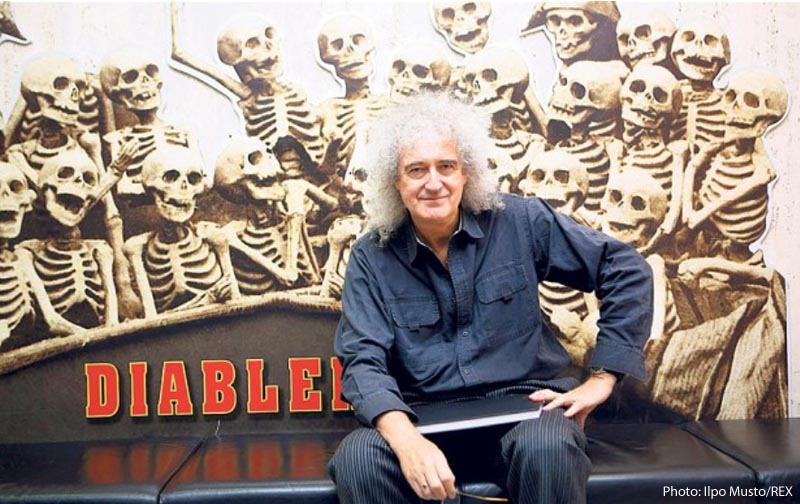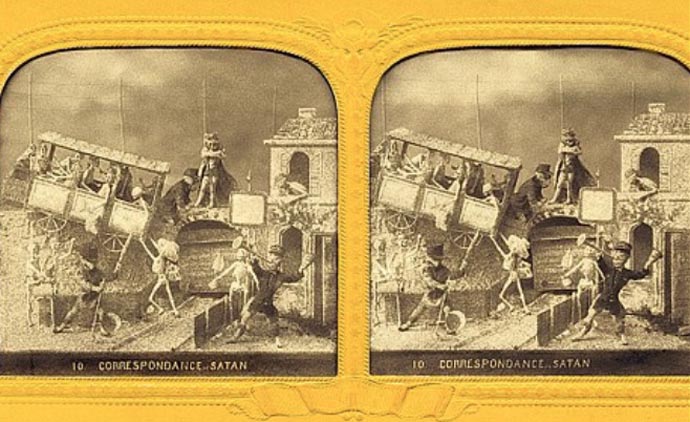TELEGRAPH
26 February 2014 by Brian May, Denis Pellerin and Paula Fleming
Brian May has made an exciting discovery in his quest to complete a collection of hellish 19th-century postcards

When, a few months ago, the team at the London Stereoscopic Company released our book Diableries: Stereoscopic Adventures in Hell, we had located and reproduced 180 out of the known 182 Diableries — picture cards of demonic scenes designed for stereoscopic viewers in Paris in the middle years of the 19th century.
As explained in an article we wrote October last year, Diableries are colourful and infernally detailed three-dimensional images that provide a fascinating insight into the imagination of the past.
But they are not easy to find. When we produced the book we knew there were still two cards out there that had escaped us, but had no information about them except for their supposed titles, given to us by a collector who couldn’t remember who he had got them from. We are now delighted to announce that, thanks to Dutch collector Jan Lagendijk, who outsmarted everyone, only one Diablerie remains to be traced.
Jan contacted us a few weeks ago and sent us a low-resolution picture of a card which, despite its poor quality, was the most exciting piece of news on the Diableries front we had had for months. Then came a high-resolution scan, followed a few days later by the card itself, which Jan kindly agreed to trade. From the depth of our mortal souls, thank you Jan!
Well, our information on this missing title was incorrect: the newly discovered card is not called Au Pays de Satan, as we had previously thought, but Correspondance de Satan. It’s number 10 in what we have called the EH series, because these cards often appear on mounts bearing these initials.

EH stands for Eugène Hanau, a camera inventor and photographic publisher. The EH series, now complete, comprises 12 cards, all published circa 1884 but never copyrighted.
What does the newly discovered card show? “Correspondance” has several meanings in French. It can be used — as in English — to describe an exchange of letters, similarities between different things (there is a famous poem by Charles Baudelaire called “Correspondences”). Or it can mean the kind of connection we make on a journey, from one train or plane to another. In this Diablerie card, it is this last meaning that is intended.
Correspondance de Satan is one of the five Diableries that deal with the newly invented railway, implying it’s an invention of the Devil. The others are Chemin de fer infernal, Œuvres du Diable, Une Machine Infernale, and Gare de l’Enfer, which are all illustrated in full 3D in our book.
As with most of the cards belonging to this series, what’s happening in this tableau is far from clear. The scene takes place outside a railway station, near a tunnel, seen in the background. There is apparently a track running on top of the tunnel and the Devil is standing there, holding the lever operating a set of points. In the foreground, on the right, another signalman is operating a different set of points, his action being watched by two skeletons. Between these figures, a railway coach filled with skeletons is suspended in mid-air, its “landing” being supervised by a shunter whose job is apparently to couple it to a train waiting at the entrance of the tunnel. At the front of the passenger coach, a brakeman is applying the safety brake as though it were of some use and everybody’s life (though they are already dead anyway) depended on it. In those days, railway coaches were equipped with a brake which could be operated manually by the brakeman if the train needed to slow down.
On the right of the picture can be seen a skeleton holding a flag, and the station master blowing a horn and ringing a handbell. In the 1860s, the station master usually blew one long blast of his trompe (trumpet) or corne (horn) to signal the approach or departure of a train. Several short blasts of the horn would signify danger. The bell was normally used when the train was about to leave. We may assume that by using both at the same time the station master is giving warning that a delicate and somewhat dangerous operation is in progress. It appears from all these elements that, by pushing the lever on top of the tunnel, the Devil has made the coach come off the upper track and float gently down onto the lower track, where it will be coupled to the waiting train.
Usually, passengers who have a train connection have to get off the coach and catch another train leaving from another platform. In this infernal version of a connection it seems to be the coach itself that changes tracks, which is very odd. But the lower track goes straight into a tunnel, and probably straight to hell after that. So maybe the whole “changing the track” scenario has been engineered by the Devil, who has derailed the train on the “upper” track, so it can be redirected into the infernal regions, with its payload of new recruits.
As with the other cards of this series, there is no real satire or political message here. But, in the absence of cars or planes, it was shipwrecks and train crashes which made the headlines, so this card is perhaps an assertion that travelling by train was devilishly dangerous. Although safety had been considerably improved since the days of the first railways, accidents were still common and often caused, not by power or mechanical failure, but by human errors. Between January 1880 and December 1884 there were 23 train disasters in France, killing 63 people and injuring many more. This card must have been a grim reminder of such tragedies.
So the EH series is now complete.
There is now only one Diablerie remaining to be found. It belongs to the last series to be made, which we have designated “F”, for Final. Until now, we believed its title was Un Rêve (A Dream), but this may not now be the case. We can be fairly sure it will be number 12 in the series. However, titles and numbers in this series are often hidden by the mount, so there might actually be very little to go on – except that this card will be something as yet unseen.
Surely there is one copy of the missing F12 out there! Please help us look out for anything that might be a candidate. It will probably not look very impressive – very likely faded, with low contrast and in generally bad condition; but, whatever state it’s in, it will be that last missing piece of the Diableries jigsaw puzzle. And then there was one… The hunt is on!
Diableries: Stereoscopic Adventures in Hell (Carlton Books, £40, with Owl viewer) is available from Telegraph Books (0844 875 1514) for £36 plus £1.35 p&p